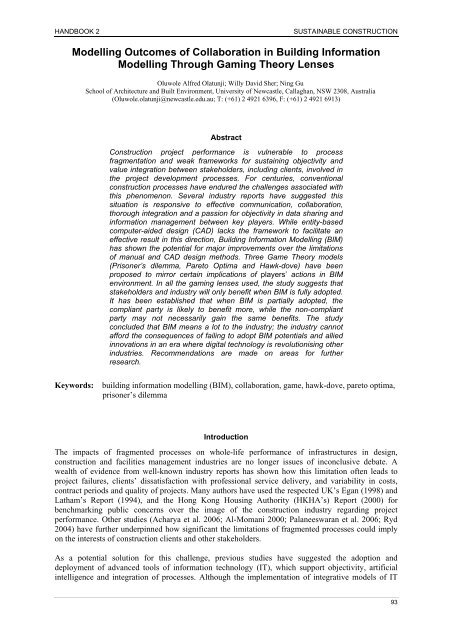Industrialised, Integrated, Intelligent sustainable Construction - I3con
Industrialised, Integrated, Intelligent sustainable Construction - I3con
Industrialised, Integrated, Intelligent sustainable Construction - I3con
Create successful ePaper yourself
Turn your PDF publications into a flip-book with our unique Google optimized e-Paper software.
HANDBOOK 2 SUSTAINABLE CONSTRUCTION<br />
Modelling Outcomes of Collaboration in Building Information<br />
Modelling Through Gaming Theory Lenses<br />
Oluwole Alfred Olatunji; Willy David Sher; Ning Gu<br />
School of Architecture and Built Environment, University of Newcastle, Callaghan, NSW 2308, Australia<br />
(Oluwole.olatunji@newcastle.edu.au; T: (+61) 2 4921 6396, F: (+61) 2 4921 6913)<br />
Abstract<br />
<strong>Construction</strong> project performance is vulnerable to process<br />
fragmentation and weak frameworks for sustaining objectivity and<br />
value integration between stakeholders, including clients, involved in<br />
the project development processes. For centuries, conventional<br />
construction processes have endured the challenges associated with<br />
this phenomenon. Several industry reports have suggested this<br />
situation is responsive to effective communication, collaboration,<br />
thorough integration and a passion for objectivity in data sharing and<br />
information management between key players. While entity-based<br />
computer-aided design (CAD) lacks the framework to facilitate an<br />
effective result in this direction, Building Information Modelling (BIM)<br />
has shown the potential for major improvements over the limitations<br />
of manual and CAD design methods. Three Game Theory models<br />
(Prisoner’s dilemma, Pareto Optima and Hawk-dove) have been<br />
proposed to mirror certain implications of players’ actions in BIM<br />
environment. In all the gaming lenses used, the study suggests that<br />
stakeholders and industry will only benefit when BIM is fully adopted.<br />
It has been established that when BIM is partially adopted, the<br />
compliant party is likely to benefit more, while the non-compliant<br />
party may not necessarily gain the same benefits. The study<br />
concluded that BIM means a lot to the industry; the industry cannot<br />
afford the consequences of failing to adopt BIM potentials and allied<br />
innovations in an era where digital technology is revolutionising other<br />
industries. Recommendations are made on areas for further<br />
research.<br />
Keywords: building information modelling (BIM), collaboration, game, hawk-dove, pareto optima,<br />
prisoner’s dilemma<br />
Introduction<br />
The impacts of fragmented processes on whole-life performance of infrastructures in design,<br />
construction and facilities management industries are no longer issues of inconclusive debate. A<br />
wealth of evidence from well-known industry reports has shown how this limitation often leads to<br />
project failures, clients’ dissatisfaction with professional service delivery, and variability in costs,<br />
contract periods and quality of projects. Many authors have used the respected UK’s Egan (1998) and<br />
Latham’s Report (1994), and the Hong Kong Housing Authority (HKHA’s) Report (2000) for<br />
benchmarking public concerns over the image of the construction industry regarding project<br />
performance. Other studies (Acharya et al. 2006; Al-Momani 2000; Palaneeswaran et al. 2006; Ryd<br />
2004) have further underpinned how significant the limitations of fragmented processes could imply<br />
on the interests of construction clients and other stakeholders.<br />
As a potential solution for this challenge, previous studies have suggested the adoption and<br />
deployment of advanced tools of information technology (IT), which support objectivity, artificial<br />
intelligence and integration of processes. Although the implementation of integrative models of IT<br />
93






